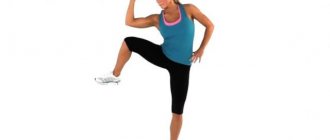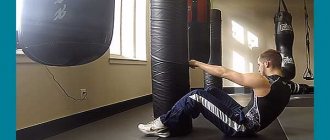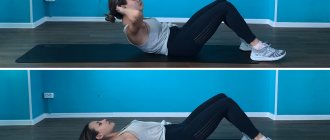The transverse abdominal muscle is the inner layer of the abdominal muscles. Unlike the rectus abdominis muscle, which is located vertically on the front surface of the body, the transverse muscle is located horizontally and encircles the waist, like a belt.
The key function of the transverse muscle is to support the internal organs, as well as assist the diaphragm in the breathing process. Its work is closely related to the work of the oblique abdominal muscles (they are located on the sides of the body), and the best exercises for development are leg raises and turns.
Exercises for the transverse muscle
Weak transverse muscles are a common problem for people who spend most of the day sitting and do not exercise their abs. The presence of visceral fat also negatively affects the tone of the internal abdominal muscles, stretching them. That is why it is important to strengthen the internal muscles with exercises:
Lifting arms and legs while lying down
Starting position: lying on your stomach, arms and legs extended. Tighten your abs, pull in your stomach, then slowly lift your arms and legs about 30-40 cm up. Hold for 1-2 seconds and return to the starting position. Perform 3-4 sets of 8-12 repetitions.
// Exercises to strengthen the lower back
Lying oblique crunches
Starting position - lying on your back, one leg bent at the knee on the floor, the other laid up. Hands behind your head - but without excessive pressure. As you exhale, slowly reach your elbow toward the opposite knee, contracting your abs. Perform 2-3 sets of 12-15 repetitions on each side.
// Oblique abdominal muscles - how to pump?
Pulling your knees to your chest
Starting position - lying on your back, legs bent at the knees and raised up. The abs are pulled out in a line, the buttocks are slightly lifted off the floor. Using the strength of the transverse abdominis muscle, slowly pull your knees towards your chest, then return to the starting position without losing muscle control. 3-4 sets of 12-15 repetitions.
// How to pump up your lower abs?
Advanced crunches
Starting position - similar to the previous exercise. Place your hands on your head. Slowly lift your upper body, directing your elbows toward your knees—contracting your abs as much as possible as you crunch. Make sure that your hands do not put pressure on your head. Perform 3-4 sets of 12-15 repetitions.
// Crunches - how to do them correctly?
Regular crunches
After a more complicated variation of the exercise, perform classic crunches, but with an emphasis on the work of the transverse muscle. To do this, as you rise up, exhale the air from your lungs as much as possible, imagining that your waist circumference is decreasing as much as possible.
Spinal deflection while lying down
An exercise to cool down and develop spinal mobility. Lying on the floor with your stomach down, use your back muscles to lift your upper body. Do not push with your hands, use them only for support. Pause at the top, tensing your abdominal muscles. 2-3 sets of 30-60 seconds
HOW IT WORKS?
Let's look at an example where we need to lift a heavy load from the floor.
A) The movement pattern is “exhalation load”; while lifting the load, the diaphragm rises with exhalation, the transverse muscle contracts in a ring, increasing intra-abdominal pressure, providing stability to the spine. This is the healthiest way to move under load.
B) The “straining load” movement pattern. To create additional extreme stability under excessive loads, inhale, close the glottis while tensing the exhalation muscles and hold the exhalation - what is called STRAINING, the “cushion” of intrathoracic pressure becomes more elastic, air fills the lungs and, in cooperation with the tense, lowered diaphragm, this gives more stability. The transversus muscle normally at the same time provides stability to the abdominal region, increasing intra-abdominal pressure ADEQUATE TO EXTERNAL LOAD. In such a situation, a lot of stress goes to the pelvic floor, which must contain the extremely increased pressure (and not disgrace itself).
In both cases, our lumbar region requires stability in order to move safely. And we see how interesting and complex biological mechanisms for overcoming external stress have been given to us by nature for survival.
AND WHAT WILL HAPPEN IF WE, FOR EXAMPLE, WEAR A WEIGHTLIFTING BELT ON A PERSON?
Over time, the nervous system will adapt to the fact that instead of contracting the transverse abdominal muscle, you can rely on the external frame in the form of a belt. The neuromuscular control of the movement pattern changes and gradually becomes part of life. And now, under load, instead of a stable spine, a person has a completely traumatic position. Hernias and problems will arise not when he “pulls” super-heavy weights with a belt, but when he removes his suitcase from the top shelf while traveling.
AFTER BIRTH OR WHEN THE TRANSVERSE ABDOMINUS MUSCLE IS WEAK FOR SOME REASONS
When the transverse abdominis muscle, for one reason or another, is not able to provide adequate intra-abdominal pressure, this has a direct impact on the internal organs, metabolism, peristalsis and much more, which we, trainers, have no idea about.
The intestines swell and begin to push the abdominal walls from the inside, which gradually worsens the problem. In such a situation, the pelvic floor also cannot be in good condition, and failure of the transverse abdominal muscle ultimately results in incontinence and other intimate problems. And the worse it gets, the worse and worse it gets.
Also, the inability to stabilize and maintain intra-abdominal pressure goes hand in hand with a problem that doctors call VERTICAL DEFICIT - when a person is unable to effectively maintain his musculoskeletal system in an upright state for upright walking, the balance of the flexor and extensor muscles is disturbed and all this together leads to to systemic problems of varying severity.
In some such cases, doctors recommend temporarily wearing a corset on the abdominal area, which will act as a “crutch” and somewhat normalize the pressure of the organs, “collect” the intestines and contribute to a return to normal verticalization. But this is a temporary measure that will not be effective without training the stability of the whole body - mobility of the chest, working with the feet and pelvic floor, improving the mobility of the hip joints and mandatory training of the gluteal muscles, back muscles and core.
Diaphragmatic breathing: strengthening the abdominal muscles without intense exercise
The diaphragm is a muscle that separates the abdominal and thoracic cavities and represents a kind of “dome”. She is responsible for:
- ensuring the movement of food through the esophagus;
- outflow of blood from internal organs to the heart;
- breathing and maintaining pressure in the pleural cavity.
If this muscle is not strengthened enough, the patient may experience:
- displacement of internal organs, their compression by the ribs due to incorrect position;
- protrusion of the abdomen forward;
- hydrothorax and pleurisy due to impaired outflow of fluid in the pleural area;
- intercostal neuralgia. If the diaphragm is hypertonic, or, conversely, hypotonic, then an imbalance of the abdominal muscles occurs. The muscle groups of the pelvis and sternum become involved, and the axis of the spine gradually shifts, touching the nerve endings and causing severe pain in the person.
Where is the diaphragm located?
This muscle is always dynamic and forms an arch in shape, but finding or feeling it right away is not an easy task. You should orient yourself to the place under the ribs (IV rib on the right and V on the left, since the diaphragm is an unpaired muscle and is located with a slight deviation).
The muscle tissue of the diaphragm also covers the area of the sternum, lower back and the place of attachment of the xiphoid process to the ribs (the most vulnerable area).
To find the “dome”, it is important not only to understand the approximate location, but also to feel it. The easiest way to do it is this way.
- Lie down on the floor.
- Place a book on your stomach (it should be quite heavy, but not too much; it is needed as a load).
- Take in a lot of air through your nose and fill your stomach with it. The chest should not be allowed to move. The book should rise with your stomach. If this does not happen, it means that the diaphragm has not yet been found.
- Exhale through your nose.
After these manipulations, you need to repeat all the steps several more times. It is important to feel the resistance of the abdominal muscles, their strength and ability to lift small loads. This indicates they are working correctly.
You can’t suck in your stomach, and you should exhale a little longer than inhale. This will help balance the air flow inside the abdominal cavity.
How to Prepare for Basic Breathing Exercises
- The exercises need to be performed twice a day for 10 minutes, so you need to set aside free time for exercise.
- The room should be well ventilated, and it is best to conduct training in the fresh air.
- It is better to refrain from eating at least 3 hours before gymnastics.
- Clothing for sports should be comfortable. The ideal option would be cotton materials that have good hygroscopicity and the ability to pass air.
- Feeling normal and having a positive attitude are a guarantee of proper exercise. If you feel unwell, you should stop doing breathing exercises.
The main exercises for the diaphragm
Working with the diaphragmatic region helps develop a new type of breathing - belly breathing, since most people are accustomed to breathing from the chest.
Shallow breathing disrupts the balance of the body and interferes with proper blood supply to tissues. When breathing diaphragmatically, it is important to remember that:
- As you inhale, the diaphragm muscle contracts and expands.
- As you exhale, the diaphragm relaxes and returns to its natural position.
Finding the aperture using a book can also be used as an independent exercise. When the abdominal muscles have already become accustomed to the load, you can remove the book and place your hands on your stomach and chest to monitor the work of the muscle frame.
Breathing exercises can also be done while sitting. To do this, you need to choose a comfortable chair, sit on it, and relax. It is better to close your eyes to focus on the sensations. The same rules apply as when lying down: it should not be too intense, and the main thing is to maintain a comfortable rhythm. Exhalation cannot be forced - only with the help of the diaphragm. It is recommended to carry out this exercise for 15-20 minutes.
“Dog breathing” is often included in treatment complexes for the development of the diaphragm. The patient gets down on all fours, relaxes the abdominal muscles and straightens the back, and then inhales and exhales intensely through the mouth with high frequency.
This exercise should be performed by more experienced patients who are familiar with the basics of breathing exercises, and best under the supervision of a doctor. The fact is that such breathing, due to frequent inhalations/exhalations, can cause hyperventilation syndrome and lead to undesirable consequences such as dizziness, nausea, and weakness due to too rapid saturation of the body tissues with oxygen.
The benefits of diaphragmatic breathing
The main problem encountered by most people is shallow breathing and improper air exchange. Diaphragmatic breathing is a path to a process designed by nature.
Patients suffering from back problems that do not allow them to do strenuous abdominal exercises (for example, pinched nerves) have the opportunity to strengthen their back and abdomen without harm to the body.
The diaphragm massages the internal organs, and their functioning improves due to blood flow. Some note that breathing exercises even help to lose weight.
Exercises on the diaphragm are a gentle way to support the muscles of the lumbosternal frame, straighten the spinal axis, and also saturate the body with oxygen.
Mastering deep belly breathing may seem like a difficult task at first, but with regular practice you can achieve amazing results.
It’s just important to remember that even such useful gymnastics may have contraindications, so all complexes are carried out strictly under the supervision and on the recommendations of qualified specialists. Author: K.M.N., Academician of the Russian Academy of Medical Sciences M.A. Bobyr
Warm-up for the abdominals[edit | edit code]
Abdominal exercises can be performed at the beginning or end of your workout. If you do them at the end of your workout, you don't need to warm up separately. Perform a warm-up set of abdominal exercises without weights if you plan to use them in the future. If you're starting your workout with abdominal exercises, perform at least one light set of crunches before moving on to more intense exercises. Read more:
Warm-up in bodybuilding
Tips for training
- “Consistency gives results” is the best answer to the question of how to build muscles. This is exactly the motto you should adhere to on the path to a beautiful and aesthetic body. You shouldn’t expect quick results and don’t set unrealistic goals for yourself, otherwise this will only lead to disappointment. Do everything gradually, over a large amount of time, 3-4 times a week, remembering to give your muscles rest.
- When training your abs, diet and moderate nutrition play an important role. Without observing this, you may simply not notice the results due to the large amount of subcutaneous fat on the abdomen. If you are overweight, you need to consume fewer calories per day than you burn. You can create such a diet yourself, or use the services of a fitness trainer.
- Try to eat foods rich in protein, and it is better to eat higher carbohydrate foods immediately after training. This way, it will not have time to be deposited in fat folds, but will go straight to muscle restoration.
- In addition to this, it is worth noting that the abs are indirectly pumped up from other exercises; for example, in many athletes or “horizontal bar men” who do not specifically work on the abs, it is visible, although not as pronounced as in bodybuilders. That is why, for a more aesthetic and pleasant look, you need to purposefully work on it, both on the abdominal and internal parts.
If you found this article useful, be sure to subscribe to blog updates. Here you will find a lot of tips and tricks that will tell you how to stay healthy and get in good physical shape. And don’t forget to share with your friends on social networks.
In conclusion, so to speak - on topic, I would like to advise you to read the article, which talks about working out the lateral abdominal muscles, since we have already talked in detail about the press. From there you can learn many useful and new exercises for both men and women.
comments powered by HyperComments
PS Subscribe to blog updates,
so you don't miss anything!
I also invite you to my Instagram
External oblique muscle
The abdominal muscle mass is the largest and most superficial of the four muscles and lies along the sides and front of the abdomen. It is wide and thin, its muscular part occupies the lateral side, and the aponeurosis occupies the anterior wall of the abdomen. It extends from the outer surface and lower borders of the last eight ribs. The fibers (inferior) from the lowest ribs run almost vertically downwards and are inserted into the anterior half of the iliac crest; the middle and upper fibers, directed downward and anteriorly, end in an aponeurosis approximately in the middle of the clavicular line and are attached to the xiphoid process, linea alba, crest of the pubis and pubic tubercle.
Friends, Marina Osokina’s seminar “Women’s health: opportunities for restorative fitness and physical therapy” will take place very soon. Find out more...
Innervation
The abdominal ICM is innervated by six lower thoracic nerves, the iliohypogastric and ilioinguinal nerves.
Function
Acting together, the external oblique muscles of the abdomen flex the spinal column, pulling the pubis towards the xiphoid process. Contraction of one LCM results in ipsilateral lateral flexion and contralateral rotation of the trunk.
General information
Abdomen - the space between the sternum and pelvis
The abdomen refers to the space of the body between the chest and pelvis. The basis of the internal structure of the abdomen is the abdominal cavity, which contains the digestive and excretory organs.
Anatomically, the area is limited by the diaphragm, located between the thoracic and abdominal cavities. The pelvic region begins at the level of the pelvic bones.
The structural features of the abdomen and abdominal cavity determine many pathological processes. The digestive organs are held together by special connective tissue, the mesentery.
This tissue has its own characteristics of blood supply. The abdominal cavity also contains organs of other important systems - the kidneys and spleen.
Many large blood vessels supply the tissues and organs of the abdominal cavity. In this anatomical region, the aorta and its branches, the inferior genital vein and other large arteries and veins are distinguished.
The organs and main vessels of the abdominal cavity are protected by muscular layers that form the external structure of the abdomen.










